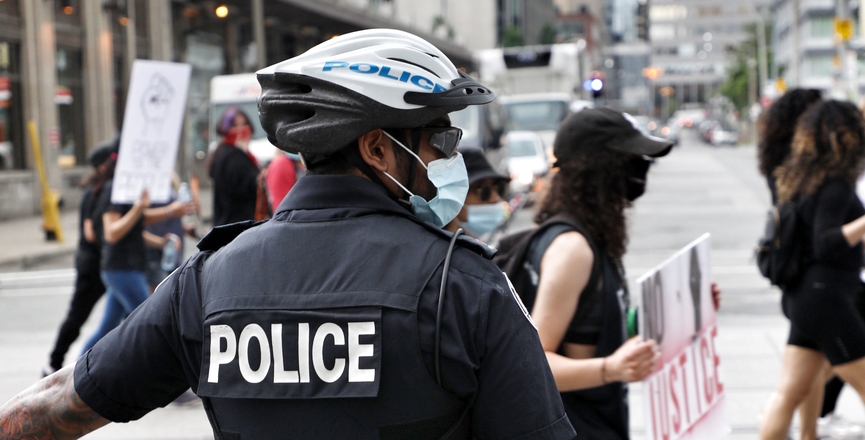According to Statistics Canada, the total operating expenditures of police across Canada have generally been increasing since 1996-1997 (data from 1987 to 2018). Now, as protests against police violence are spreading across North America, voices of activists and people who have been working with racialized and vulnerable communities demanding Canada defund and disarm police are being amplified.
This blog is about providing us with tools we can use when making our case in support of Black Lives Matters’ call to defund and disarm the police.
What does police violence look like in Canada?
Each community has a list of names of people who have been harmed by discriminatory policing. There is no comprehensive list of people harmed, but Pivot Legal has provided a report summarising “17 years of police violence in Canada,” based on the CBC’s investigative series called “Deadly Force.” Here is a great post by Leadnow about police violence in the past 67 days. And this chapter from Policing Black Lives by Robin Maynard provides an initiation to the history of discriminatory policing in Canada.
Here are statistics from the John Howard Society which show the extent of overrepresentation of Black and Indigenous people in our criminal system. As pundits and right-wing media try to manipulate our perception of the racial attitudes of other Canadians, the “Race Relations in Canada, 2019 Survey” report provides data about the real attitudes of people.
What does “defund the police” mean?
Defunding the police means reducing police budgets and reallocating those funds to crucial and often neglected areas like education, public health, housing and youth services. These much needed community support services have faced cuts while the total operating expenditures of police have generally increased for over two decades.
In 2018, an “OECD study looking at how much countries spend on services, benefits and tax breaks related to healthcare, families, old age security, unemployment, housing and more, found Canada’s public social expenditures fall well below the OECD average — even lower than the United States,” reported Press Progress.
One of the roots of over-policing and discriminatory policing is that as social supports become inadequate, the police are called in to address social problems — like poverty, mental illness, homelessness and addiction — which they are poorly equipped to handle. As we defund needed social supports in favour of a “law and order” approach, more and more vulnerable people are hurt.
What is happening in the First Nations and Indigenous communities?
In the 1990s, the federal government and First Nations communities developed the First Nations Policing Policy. Here is a history of how the policy developed and was continuously underfunded.
In 2016 The Nishnawbe-Aski Police Service (NAPS) officers voted in favour of a strike action to demand that the the Ontario government to improve working conditions for First Nations officers. According to a CBC article, “not only were NAPS officers paid less than their provincial counterparts, but they were forced to work without radios and patrol without partners. Police detachments in isolated First Nations often lacked jail cells or running water.”
In 2018, Ottawa committed to spending $291 million over five years on policing in First Nations and Inuit communities in Canada. NAPS salaries are now in line with other police forces in Ontario, and the additional funding will improve conditions and equipment for officers. However at there are two cases by the Mashteuiatsh First Nation in Quebec and the Mushkegowuk Council in northern Ontario demanding additional resources for First Nations policing.
Since the murder of George Floyd, reports have circulated about the deaths of two Indigenous people at the hands of police, and a video showing police brutally tackling and punching Athabasca Chipewyan First Nation Chief Allan Adam. The Assembly of First Nations (AFN) is calling for a complete overhaul of the policing system in Canada.
Many First Nations communities have just gotten hard won resources for a chronically underfunded self-governed system, and they need more resources. However, it is important to note that the per capita federal expenditure on policing in the three territories is very high. Part of AFN’s call for an overhaul is to redirect resources to First Nations-led community policing.
What changes are being proposed in Canada?
Right now, announcements of governments examining police budgets are everywhere in mainstream media. In Victoria, the B.C. government is being asked to scrutinize the militarization of police, in particular focusing on the purchase of a heavily armoured car in 2017. B.C.’s provincial government has committed to reviewing the Police Act. In Toronto, city council is reviewing a proposal to cut the police budget by 10 per cent. In Calgary, activists are calling for caps to police budgets. Keep local and national movements going after mainstream media moves on and the spotlight fades.
What are some of the Black Lives Matter movement’s achievements to date?
On July 20-21, 2016 the Movement for Black Lives, a coalition of the three organizations — Black Lives Matter, the Black Youth Project 100 (BYP100) and the Million Hoodies — launched the #Freedomnow movement to defund police departments and redirect money to community needs. Here is a great article by the American Civil Liberties Union about how the U.S. Black Lives Matter movement built change and continues to build a revolution.
In Canada, in the early 1990s, public complaints, legal actions, empirical research and a number of high-profile incidents shined a spotlight on racial bias in policing. The Canadian Civil Liberties Union published this history of the movement against racial profiling and policing. A lot has been accomplished, but with ever increasing pressure to defund social programs and to continue building the law enforcement and prison industries, a lot more still needs to be done.
Image: Mitchel Raphael




